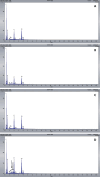Occlusion, acid resistance, and elemental characterization of dentin treated with desensitizing agents
- PMID: 39936715
- PMCID: PMC11808701
- DOI: 10.1590/1807-3107bor-2025.vol39.016
Occlusion, acid resistance, and elemental characterization of dentin treated with desensitizing agents
Abstract
The objective of this study was to evaluate the occlusion potential of in-office desensitizing agents, and characterize the human dentin elements after acid exposure. Twelve human dentin discs were sectioned into four specimens each, and randomized into treatments (n = 20): no treatment (negative control); no treatment and 6% citric acid exposure (positive control); application of Gluma desensitizer (Heraeus Kulzer) or PRG Barrier Coat (Shofu), followed by 6% citric acid exposure. Occlusion and dentin surface characteristics were determined by scanning electron microscopy (SEM, n = 10), and elemental composition (at%), by energy-dispersive X-ray spectroscopy (EDS, n = 10). Three calibrated, blinded evaluators used SEM to categorize the occlusion potential: 1 = occluded, 2 = partially unoccluded, 3 = equally occluded/unoccluded, 4 = partially occluded, 5 = unoccluded. Data were analyzed by weighted kappa, Friedman, and Nemenyi tests (α = 0.05). For SEM, mean occlusion scores were higher for the PRG Barrier Coat than the positive control (p = 0.0235). Most specimens in the controls scored 4 or 5. The most frequent scores for PRG Barrier Coat were 1(60%) and 2(20%), while 30% of Gluma specimens scored 1 and 2. Gluma showed intratubular precipitation, while PRG Barrier Coat covered dentinal tubules totally or partially. For EDS, the K% was lower for Gluma than the negative control (p = 0.0046), with Si peaks in dentin treated with PRG Barrier Coat. The bioactive in-office desensitizing agent with S-PRG filler (PRG Barrier Coat) promoted dentin tubule occlusion, and persisted after exposure to acid.
Conflict of interest statement
Figures
Similar articles
-
In vitro dentin permeability after application of Gluma® desensitizer as aqueous solution or aqueous fumed silica dispersion.J Appl Oral Sci. 2011 Apr;19(2):147-53. doi: 10.1590/s1678-77572011000200011. J Appl Oral Sci. 2011. PMID: 21552716 Free PMC article.
-
Effects of different desensitizers and lasers on dentine tubules: An in-vitro analysis.Microsc Res Tech. 2017 Jul;80(7):737-744. doi: 10.1002/jemt.22859. Epub 2017 Mar 2. Microsc Res Tech. 2017. PMID: 28251725
-
Occluding effect of Nd:YAG laser and different dentin desensitizing agents on human dentinal tubules in vitro: a scanning electron microscopy investigation.Oper Dent. 2012 Jul-Aug;37(4):340-55. doi: 10.2341/10-188-L. Epub 2012 Feb 7. Oper Dent. 2012. PMID: 22313266 Clinical Trial.
-
Effectiveness and acid/tooth brushing resistance of in-office desensitizing treatments-A hydraulic conductance study.Arch Oral Biol. 2018 Dec;96:130-136. doi: 10.1016/j.archoralbio.2018.09.004. Epub 2018 Sep 12. Arch Oral Biol. 2018. PMID: 30237094
-
Comparison of in vitro dentinal tubule occluding efficacy of two different methods using a nano-scaled bioactive glass-containing desensitising agent.J Dent. 2017 May;60:63-69. doi: 10.1016/j.jdent.2017.03.001. Epub 2017 Mar 4. J Dent. 2017. PMID: 28267581
References
Publication types
MeSH terms
Substances
LinkOut - more resources
Full Text Sources




